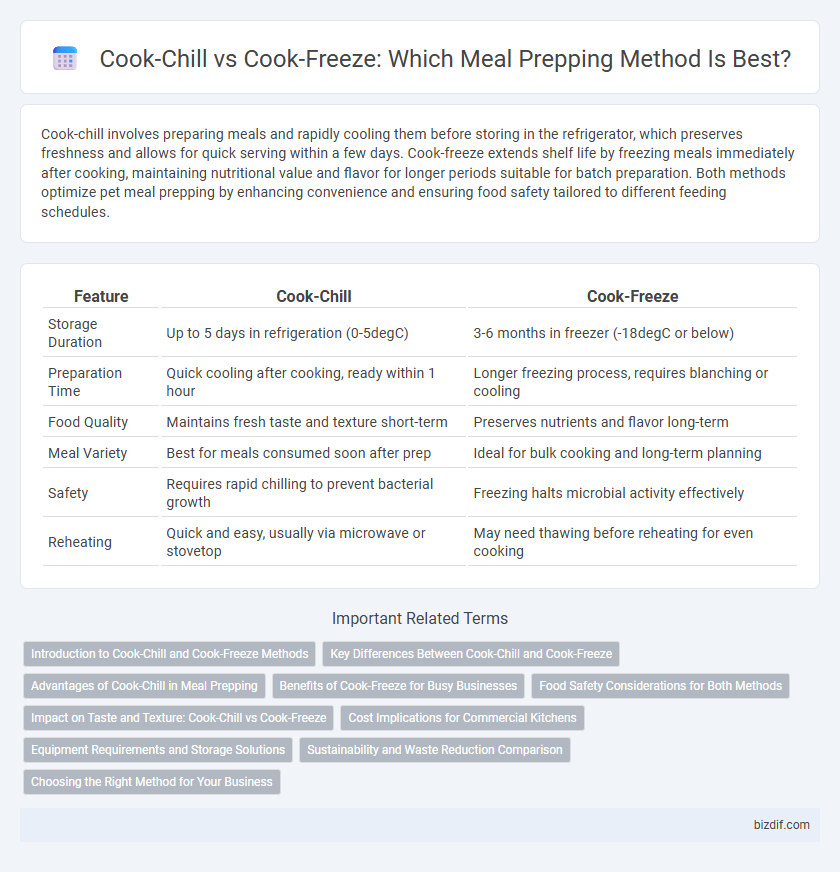Cook-chill involves preparing meals and rapidly cooling them before storing in the refrigerator, which preserves freshness and allows for quick serving within a few days. Cook-freeze extends shelf life by freezing meals immediately after cooking, maintaining nutritional value and flavor for longer periods suitable for batch preparation. Both methods optimize pet meal prepping by enhancing convenience and ensuring food safety tailored to different feeding schedules.
Table of Comparison
| Feature | Cook-Chill | Cook-Freeze |
|---|---|---|
| Storage Duration | Up to 5 days in refrigeration (0-5degC) | 3-6 months in freezer (-18degC or below) |
| Preparation Time | Quick cooling after cooking, ready within 1 hour | Longer freezing process, requires blanching or cooling |
| Food Quality | Maintains fresh taste and texture short-term | Preserves nutrients and flavor long-term |
| Meal Variety | Best for meals consumed soon after prep | Ideal for bulk cooking and long-term planning |
| Safety | Requires rapid chilling to prevent bacterial growth | Freezing halts microbial activity effectively |
| Reheating | Quick and easy, usually via microwave or stovetop | May need thawing before reheating for even cooking |
Introduction to Cook-Chill and Cook-Freeze Methods
Cook-chill and cook-freeze methods are essential meal prepping techniques that extend food shelf life and maintain nutritional quality. Cook-chill involves cooking food, rapidly cooling it to 3degC or below within 90 minutes, and storing it refrigerated for up to five days. Cook-freeze, on the other hand, requires rapid freezing of cooked meals at -18degC or lower, allowing storage for several months without significant loss of flavor or texture.
Key Differences Between Cook-Chill and Cook-Freeze
Cook-chill involves cooking food, rapidly chilling it to 0-3degC, and storing it for up to 5 days, preserving freshness and reducing bacterial growth. Cook-freeze requires cooking food followed by quick freezing at temperatures below -18degC, allowing storage for several months with minimal nutrient loss. Key differences include storage duration, temperature requirements, and texture retention upon reheating, with cook-chill providing better texture and shorter shelf life compared to cook-freeze.
Advantages of Cook-Chill in Meal Prepping
Cook-chill meal prepping offers the advantage of maintaining food freshness and texture by rapidly cooling cooked meals to extend shelf life without compromising quality. This method reduces the risk of bacterial growth by quickly reaching safe storage temperatures, making it ideal for large batch preparation and portion control. Cook-chill also allows for flexible reheating, preserving nutritional value and flavor better than cook-freeze, which can sometimes lead to texture degradation after freezing and thawing.
Benefits of Cook-Freeze for Busy Businesses
Cook-freeze meal prepping offers busy businesses extended shelf life and reduced food waste by preserving meals at ultra-low temperatures. This method enhances inventory management and supports bulk production, allowing businesses to meet high demand efficiently. Rapid freezing also maintains nutritional quality and flavor, ensuring customer satisfaction with ready-to-eat meals.
Food Safety Considerations for Both Methods
Cook-chill requires rapid cooling to 3degC within 90 minutes to prevent bacterial growth, while cook-freeze demands freezing at -18degC or lower immediately after cooking for long-term storage. Both methods must maintain strict temperature controls during reheating, with cook-chill typically reheated to at least 74degC within two hours, and cook-freeze requiring thawing under refrigeration before reheating. Cross-contamination risks can be minimized by using separate containers and hygiene protocols, ensuring food safety in both meal prepping techniques.
Impact on Taste and Texture: Cook-Chill vs Cook-Freeze
Cook-chill preserves the freshness and tenderness of meals by cooling cooked food rapidly, which maintains moisture and flavor without the formation of ice crystals. Cook-freeze extends shelf life by freezing meals quickly, but it can affect texture, causing potential dryness or graininess due to ice crystal formation that disrupts cell structure. Taste remains generally intact in both methods, though cook-chill often results in a more consistent and appealing dining experience.
Cost Implications for Commercial Kitchens
Cook-chill methods reduce energy costs by limiting cooking times and minimizing refrigeration needs compared to cook-freeze, which demands higher energy for prolonged freezing and thawing processes. Equipment investment for cook-chill is generally lower, as it avoids the need for large blast freezers required in cook-freeze operations. Labor costs can also be optimized with cook-chill due to faster turnaround and easier portioning, enhancing overall cost efficiency in commercial kitchens.
Equipment Requirements and Storage Solutions
Cook-chill requires specialized blast chillers to rapidly cool food to safe temperatures, preventing bacterial growth during storage, while cook-freeze depends on commercial-grade freezers to maintain food quality over extended periods. Cook-chill storage solutions often involve vacuum-sealed containers stored in refrigerated units, optimizing freshness and shelf life up to 5 days. Cook-freeze uses airtight, freezer-safe packaging compatible with deep storage freezers, enabling preservation for several months without compromising nutritional value or texture.
Sustainability and Waste Reduction Comparison
Cook-chill meal prepping reduces energy use by storing food at safe temperatures for shorter periods, minimizing food spoilage and waste through precise portioning and quicker turnover. Cook-freeze extends shelf life by freezing meals, which can reduce food waste but may increase energy consumption due to longer freezer use and higher electricity demand. Comparing sustainability, cook-chill offers a more energy-efficient option with lower carbon emissions, while cook-freeze provides superior waste reduction capabilities through extended preservation.
Choosing the Right Method for Your Business
Selecting between cook-chill and cook-freeze methods depends on your business's storage capacity and delivery timelines. Cook-chill is ideal for quick turnover with meals kept refrigerated for up to 5 days, ensuring freshness and immediate consumption. Cook-freeze extends shelf life up to several months, reducing waste and enabling large batch preparation, making it suitable for businesses with longer distribution channels or seasonal demand.
Cook-chill vs cook-freeze Infographic

 bizdif.com
bizdif.com